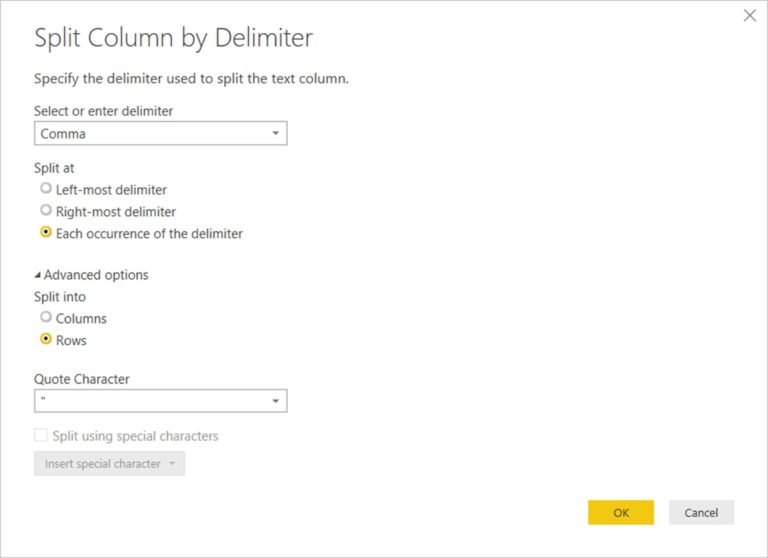Unleash the Full Potential of Power BI – Building Dynamic Hierarchies with Calculated Columns
Introduction
Power BI has emerged as a powerful tool for data analysis, enabling organizations to extract valuable insights from their vast datasets. To fully unleash the potential of Power BI, it’s essential to explore its advanced features, such as calculated columns and dynamic hierarchies. In this article, we will delve into the world of calculated columns and discover how they can be used to build dynamic hierarchies, elevating your data analysis capabilities to new heights.
Understanding Power BI Calculated Columns
Power BI offers a range of functionalities to transform and manipulate data. Calculated columns are one such feature that allows users to create custom columns based on existing data. These calculated columns are derived from expressions or formulas and provide additional insights into the dataset.
Creating Dynamic Hierarchies in Power BI
Dynamic hierarchies add a layer of flexibility and interactivity to data analysis in Power BI. By leveraging calculated columns, you can construct dynamic hierarchies that adapt to the changing needs of your analysis. To create dynamic hierarchies, follow these steps:
Identify the hierarchical structure required for your analysis.
Define the relationships between the columns involved in the hierarchy.
Use calculated columns to create the necessary levels of the hierarchy.
Test and validate the dynamic hierarchy to ensure accuracy and relevance.
Leveraging Calculated Columns for Advanced Analytics
Calculated columns in Power BI go beyond simple data transformations. They enable advanced analytics by allowing users to perform complex calculations and derive meaningful insights. With calculated columns, you can:
Perform mathematical operations on existing columns.
Apply conditional logic to categorize data.
Aggregate and summarize data at different levels of granularity.
Integrate external data sources for enriched analysis.
Best Practices for Building Dynamic Hierarchies with Calculated Columns
To ensure optimal performance and efficiency when building dynamic hierarchies with calculated columns, consider the following best practices:
Keep calculated columns concise and focused on specific requirements.
Regularly evaluate and manage the impact of calculated columns on dataset size and performance.
Optimize column naming conventions for clarity and ease of understanding.
Leverage DAX (Data Analysis Expressions) functions to simplify and streamline calculations.
Visualizing Dynamic Hierarchies in Power BI
Visual representation plays a crucial role in effectively communicating data insights. Power BI offers various visualization options to showcase dynamic hierarchies such as tree maps, sunburst charts, and drill-down visuals. When visualizing dynamic hierarchies, consider the following:
Choose the appropriate visual type that best represents the hierarchy structure.
Use interactive features to allow users to navigate through different levels of the hierarchy.
Apply formatting and styling options to enhance the visual appeal and clarity of the hierarchy.
Utilize tooltips and labels to provide additional information and context to the hierarchy.
Overcoming Challenges and Limitations
While calculated columns offer significant benefits, there are challenges and limitations to be aware of when working with them in Power BI. These include:
Performance considerations: Large datasets and complex calculations can impact query and report performance.
Memory constraints: Calculated columns consume memory resources, so it’s crucial to manage them efficiently.
Data model complexity: Overusing calculated columns can lead to a complex and challenging-to-maintain data model.
Compatibility issues: Calculated columns may not be compatible with all data sources or versions of Power BI.
To overcome these challenges and optimize the use of calculated columns, consider the following strategies:
Evaluate and optimize data model design to minimize the impact of calculated columns on performance.
Use calculated columns sparingly and focus on the most critical and relevant calculations.
Monitor and analyze performance metrics to identify bottlenecks and make necessary adjustments.
Regularly update Power BI to leverage new features and improvements that address limitations.
Conclusion
Building dynamic hierarchies with calculated columns empowers Power BI users to unlock the full potential of their data analysis endeavors. By leveraging the flexibility and versatility of calculated columns, organizations can derive meaningful insights, perform advanced analytics, and present data in intuitive and interactive ways. When used strategically and in adherence to best practices, calculated columns enable data-driven decision-making and enhance the overall effectiveness of Power BI.
Frequently Asked Questions (FAQs)
What is the difference between calculated columns and measures in Power BI?
Calculated columns are derived from existing data and can be used for various calculations and categorizations. Measures, on the other hand, are calculations performed on the fly and are typically used for aggregations and calculations at the report level.
Can calculated columns be modified or updated after they are created?
Yes, calculated columns can be modified or updated based on changing requirements. However, it’s important to consider the impact of such modifications on the data model and performance.
Are calculated columns available in all versions of Power BI?
Yes, calculated columns are a core feature of Power BI and are available in all versions, including Power BI Desktop and Power BI Service.
Can I create dynamic hierarchies without using calculated columns?
While calculated columns are the most common approach for building dynamic hierarchies, Power BI also offers other features such as calculated tables and DAX functions that can be used to achieve similar results.
How can I optimize the performance of calculated columns in Power BI?
To optimize the performance of calculated columns, consider limiting their use, managing dataset size, and regularly monitoring and fine-tuning performance metrics. Additionally, leveraging DAX functions efficiently can help improve calculation performance.
Unleash the Full Potential of Power BI – Building Dynamic Hierarchies with Calculated Columns
Introduction
Power BI has emerged as a powerful tool for data analysis, enabling organizations to extract valuable insights from their vast datasets. To fully unleash the potential of Power BI, it’s essential to explore its advanced features, such as calculated columns and dynamic hierarchies. In this article, we will delve into the world of calculated columns and discover how they can be used to build dynamic hierarchies, elevating your data analysis capabilities to new heights.
Understanding Power BI Calculated Columns
Power BI offers a range of functionalities to transform and manipulate data. Calculated columns are one such feature that allows users to create custom columns based on existing data. These calculated columns are derived from expressions or formulas and provide additional insights into the dataset.
Creating Dynamic Hierarchies in Power BI
Dynamic hierarchies add a layer of flexibility and interactivity to data analysis in Power BI. By leveraging calculated columns, you can construct dynamic hierarchies that adapt to the changing needs of your analysis. To create dynamic hierarchies, follow these steps:
Identify the hierarchical structure required for your analysis.
Define the relationships between the columns involved in the hierarchy.
Use calculated columns to create the necessary levels of the hierarchy.
Test and validate the dynamic hierarchy to ensure accuracy and relevance.
Leveraging Calculated Columns for Advanced Analytics
Calculated columns in Power BI go beyond simple data transformations. They enable advanced analytics by allowing users to perform complex calculations and derive meaningful insights. With calculated columns, you can:
Perform mathematical operations on existing columns.
Apply conditional logic to categorize data.
Aggregate and summarize data at different levels of granularity.
Integrate external data sources for enriched analysis.
Best Practices for Building Dynamic Hierarchies with Calculated Columns
To ensure optimal performance and efficiency when building dynamic hierarchies with calculated columns, consider the following best practices:
Keep calculated columns concise and focused on specific requirements.
Regularly evaluate and manage the impact of calculated columns on dataset size and performance.
Optimize column naming conventions for clarity and ease of understanding.
Leverage DAX (Data Analysis Expressions) functions to simplify and streamline calculations.
Visualizing Dynamic Hierarchies in Power BI
Visual representation plays a crucial role in effectively communicating data insights. Power BI offers various visualization options to showcase dynamic hierarchies, such as tree maps, sunburst charts, and drill-down visuals. When visualizing dynamic hierarchies, consider the following:
Choose the appropriate visual type that best represents the hierarchy structure.
Use interactive features to allow users to navigate through different levels of the hierarchy.
Apply formatting and styling options to enhance the visual appeal and clarity of the hierarchy.
Utilize tooltips and labels to provide additional information and context to the hierarchy.
Overcoming Challenges and Limitations
While calculated columns offer significant benefits, there are challenges and limitations to be aware of when working with them in Power BI. These include:
Performance considerations: Large datasets and complex calculations can impact query and report performance.
Memory constraints: Calculated columns consume memory resources, so it’s crucial to manage them efficiently.
Data model complexity: Overusing calculated columns can lead to a complex and challenging-to-maintain data model.
Compatibility issues: Calculated columns may not be compatible with all data sources or versions of Power BI.
To overcome these challenges and optimize the use of calculated columns, consider the following strategies:
Evaluate and optimize data model design to minimize the impact of calculated columns on performance.
Use calculated columns sparingly and focus on the most critical and relevant calculations.
3. Monitor and analyze performance metrics to identify bottlenecks and make necessary adjustments.
Regularly update Power BI to leverage new features and improvements that address limitations.
Conclusion
In conclusion, building dynamic hierarchies with calculated columns empowers Power BI users to unlock the full potential of their data analysis endeavors. By leveraging the flexibility and versatility of calculated columns, organizations can derive meaningful insights, perform advanced analytics, and present data in intuitive and interactive ways. When used strategically and in adherence to best practices, calculated columns enable data-driven decision-making and enhance the overall effectiveness of Power BI.
Frequently Asked Questions (FAQs)
What is the difference between calculated columns and measures in Power BI?
Calculated columns are derived from existing data and can be used for various calculations and categorizations. Measures, on the other hand, are calculations performed on the fly and are typically used for aggregations and calculations at the report level.
Can calculated columns be modified or updated after they are created?
Yes, calculated columns can be modified or updated based on changing requirements. However, it’s important to consider the impact of such modifications on the data model and performance.
Are calculated columns available in all versions of Power BI?
Yes, calculated columns are a core feature of Power BI and are available in all versions, including Power BI Desktop and Power BI Service.
Can I create dynamic hierarchies without using calculated columns?
While calculated columns are the most common approach for building dynamic hierarchies, Power BI also offers other features such as calculated tables and DAX functions that can be used to achieve similar results.
How can I optimize the performance of calculated columns in Power BI?
To optimize the performance of calculated columns, consider limiting their use, managing dataset size, and regularly monitoring and fine-tuning performance metrics. Additionally, leveraging DAX functions efficiently can help improve calculation performance.














